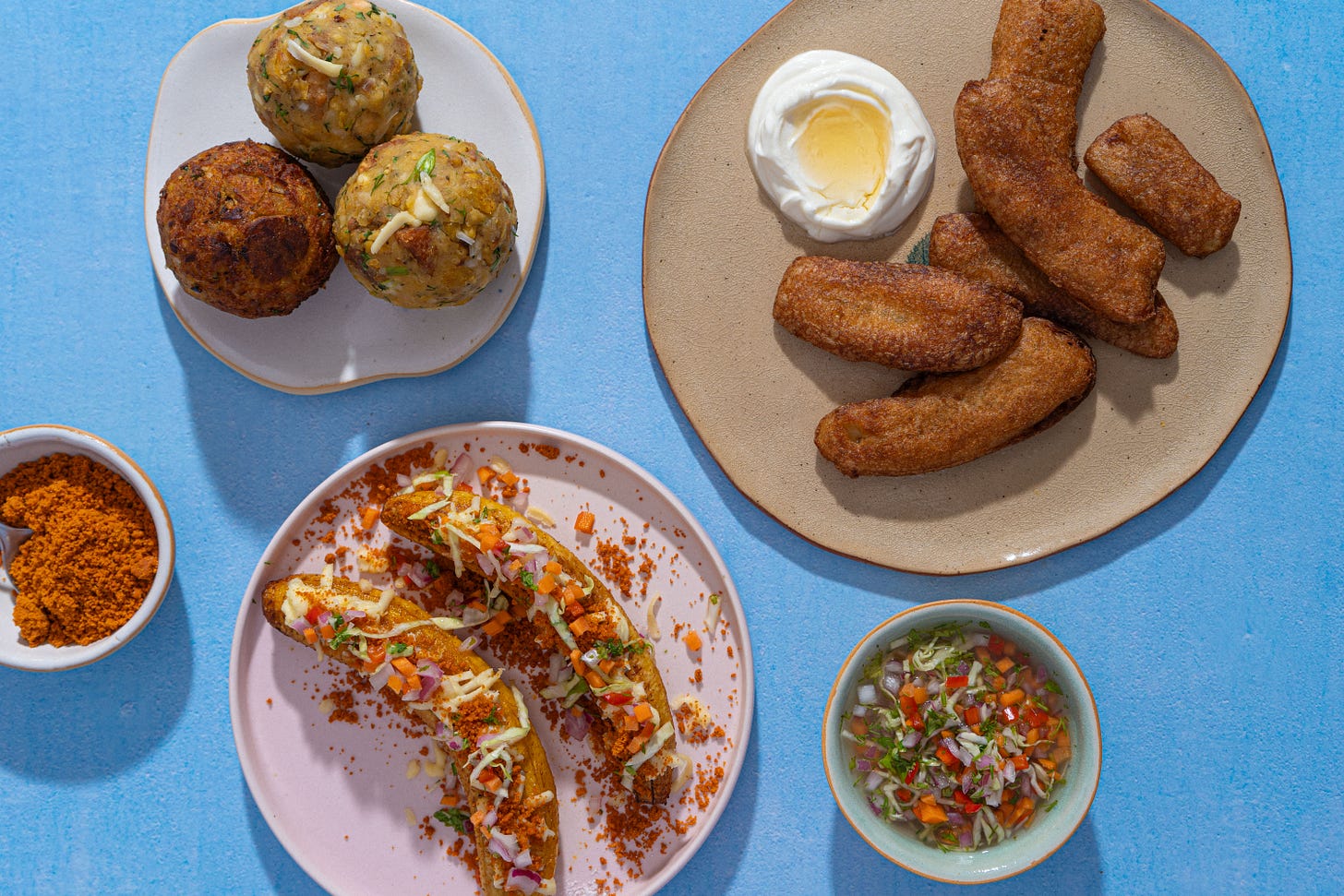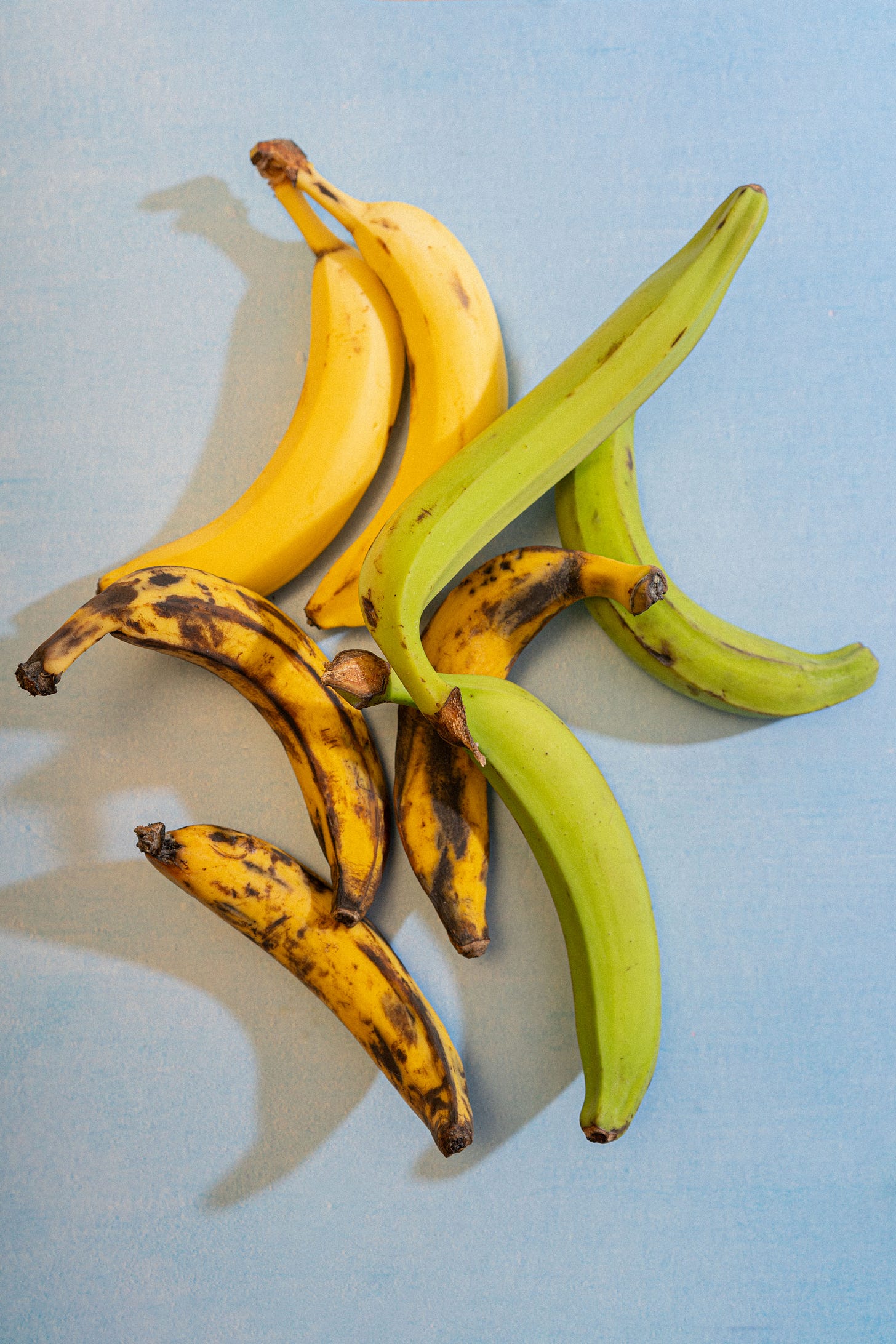A State of Bananas
A short essay plus three delicious Ecuadorian recipes using bananas and plantains. Words and photographs by Abril Macías.
Good morning, and welcome to Vittles! Today, Abril Macías writes about how corruption and political crisis have engulfed bananas in Ecuador, and shares recipes for maduros con queso, sal prieta y encurtido manaba (whole ripe plantains stuffed with cheese, peanuts and a spicy salsa); bolones de verde (mashed green plantain balls packed with porky chicharrón and hot sauce); and emborrajados de guineo (crispy banana fritters).
There are still a few copies of Issue 1 available on our website.
In my small, freezing apartment in Munich, I stare at a banana. It is pale, uniform and flavourless – the only kind available in European supermarkets. These bananas are sourced from a handful of Latin American countries, where they are grown expressly for export, harvested green and then shipped off around the world in cold, stainless-steel containers. They are just ghosts of the small, creamy, aromatic bananas I grew up with in Ecuador, which had flavours ranging from vanilla and caramel to more acidic, sour-sweet profiles that resonate with citrus and red berries. In Germany, surrounded by sterile, flavourless Chiquita bananas, I feel the full weight of their absence.
While bananas are not native to Ecuador (they were introduced by Spanish colonisers in the sixteenth century), today the country exports more of them than any other nation, feeding worldwide cravings for smoothies and pancakes and filling up lunchboxes, especially across the West. To satisfy that appetite – and guarantee the associated income – Ecuador has sacrificed local biodiversity for monoculture, with vast plantations of identical Cavendish bananas grown for the international market. Meanwhile, the non-standardised, more flavourful bananas that come in different colours, shapes and sizes (such as maqueños and oritos, along with abundant plantains) remain in the domestic market. In Ecuador, they are both comfort and sustenance, an everyday staple and indulgent treat – baked, fried or poached, or in stews, soups, desserts and snacks.
But bananas are not a simple pleasure: over the past five years, bananas have come to be at the epicentre of a conflict in Ecuador. As drug cartels have expanded their operations, banana shipments to the Global North have been used to carry cocaine. In January of last year, after a surge in violence linked to organised crime, President Daniel Noboa declared an ‘internal armed conflict’ against cartels. Despite his ostensible tough-on-crime stance, Noboa has repeatedly been linked to these same scandals. He is the heir to Grupo Noboa, one of the biggest banana-exporting empires in the world, in whose shipments cocaine has also been found, underscoring the intertwined world of power and corruption in which bananas exist.
So here I am, thousands of miles away from home, hate-eating an underwhelming banana and doomscrolling about cocaine found in Ecuadorian banana crates opened in German supermarkets. There’s only one solution: I have to reclaim bananas for myself. Not the insipid, soulless kind I find at the supermarket, but something that tastes real. I seek out bananas and plantains from African and Indian minimarkets that offer different varieties and try to recreate some of my comfort foods: adaptable, flavour-packed recipes that are nearly impossible to mess up.
I turn to three of the simplest, most joyful expressions of banana-based Ecuadorian cooking: maduros con queso, sal prieta y encurtido manaba (whole ripe plantains stuffed with cheese, peanuts and a spicy salsa); bolones de verde (mashed green plantain balls packed with porky chicharrón and hot sauce); and, to finish, emborrajados de guineo (crispy banana fritters) served with a spoonful of yoghurt and a drizzle of honey. These are the kind of recipes that work for breakfast, lunch, dinner or anytime in between. They move easily between savoury and sweet, with hints of acidity and spiciness from the sauces that go with them. When I cook these recipes, I imagine a version of my country that isn’t unravelling, one I hope can exist and that I can meet again.
Maduros con queso, sal prieta y encurtido manaba
Sal prieta is a peanut-based condiment made with salt, cumin, annatto seed oil, and corn, while ají manaba is a spicy pickled vegetable salsa featuring carrots, cabbage, onions and banana vinegar. Because banana vinegar can be hard to find outside Ecuador, I provide instructions for how to make your own simple banana-infused vinegar.
Serves 6–8 (as a starter or snack)
Time 30 mins plus at least 30 mins’ infusing
Beyond the paywall — recipe for Maduros con queso, sal prieta y encurtido manaba; plus two other banana-based snacks.





